eastern bay
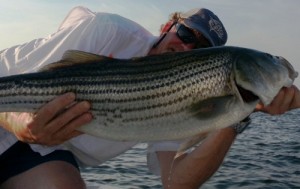 To share time-sensitive fishing information and relay real-time conditions on the water, I’ll be more active on Twitter. Last night at about 4:00 PM, I mentioned via Facebook that I would live-tweet a fishing trip starting at 5:30 PM. I’ll do this more often. Be assured that I won’t mention too many locations, but I’ll be specific about the patterns and techniques we encounter. I’ll also tweet pictures of the fish we’re catching, provide sonar shots, and share thoughts and details about hot lures and techniques. If you missed last night’s feed, you can read it on my Twitter page – @shawnkimbro. You can also follow me there to get the info live as it happens. I can’t do this all the time, but I’ll re-post last nights feed here, with some additional details and commentary inserted in italics. I’ve also cleaned up spelling and grammar since I use Google Voice instead of trying to type on my android touch-screen with wet hands. All the pictures (click the Twitter links) including the one to the left were tweeted live from the water.
To share time-sensitive fishing information and relay real-time conditions on the water, I’ll be more active on Twitter. Last night at about 4:00 PM, I mentioned via Facebook that I would live-tweet a fishing trip starting at 5:30 PM. I’ll do this more often. Be assured that I won’t mention too many locations, but I’ll be specific about the patterns and techniques we encounter. I’ll also tweet pictures of the fish we’re catching, provide sonar shots, and share thoughts and details about hot lures and techniques. If you missed last night’s feed, you can read it on my Twitter page – @shawnkimbro. You can also follow me there to get the info live as it happens. I can’t do this all the time, but I’ll re-post last nights feed here, with some additional details and commentary inserted in italics. I’ve also cleaned up spelling and grammar since I use Google Voice instead of trying to type on my android touch-screen with wet hands. All the pictures (click the Twitter links) including the one to the left were tweeted live from the water.
 Shawn Kimbro
Shawn Kimbro @ShawnKimbro 19h
Tweeting details of tonight’s fishing trip beginning 5:30 pm. #stormdodging
*I actually started a little earlier with a few preliminary details.
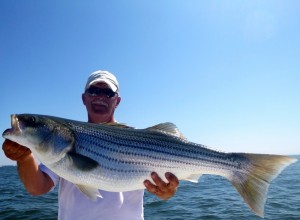 Congratulations to Rich Jenkins, 2013 Champion of the Kent Narrows Light Tackle Catch-&-Release Tournament. Rich fished with Jamie Clough, Jon Griffiths and me onboard my 27 Judge CC Thunder Road and won the tournament with a wide-shouldered 34-inch striper caught about 1:00 PM Saturday afternoon. Coming off the win, I thought it might be helpful to post some recommendations for catching bigger striped bass in Maryland’s portion of the Chesapeake Bay in June.
Congratulations to Rich Jenkins, 2013 Champion of the Kent Narrows Light Tackle Catch-&-Release Tournament. Rich fished with Jamie Clough, Jon Griffiths and me onboard my 27 Judge CC Thunder Road and won the tournament with a wide-shouldered 34-inch striper caught about 1:00 PM Saturday afternoon. Coming off the win, I thought it might be helpful to post some recommendations for catching bigger striped bass in Maryland’s portion of the Chesapeake Bay in June.
Topwater – Look around high-current points where there is access to deep water. Submerged rocks and other cover are a plus. Set up downstream and fan-cast into the direction of the current starting closest to shore. Look for the rip, that is a change in the waves around the point and work that area hard. On calm days, use a spook. In rougher water, try a big popper. Heddon Super Spooks, Lonely Angler Zipsters, and Stillwater Smackits are great lures for this time of year. Read More!
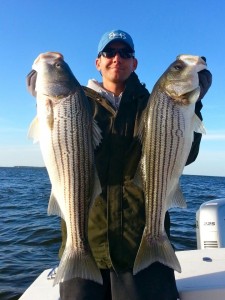 I’ve been lying low over the past couple of weeks waiting out the craziness. Most of my fishing has been in out-of-the-way places far from the madding crowds. Radios blaring, airplanes buzzing, stereos thumping, outboards droning, helicopters whirring, sirens wailing – Wow! Boat shows, trolling tournaments, and sailing regattas make the main stem of the Chesapeake very noisy. The Bay is fully awake from her winter slumber and the crowds are back in force. While we each enjoy the water in our preferred ways, to my thinking fishing should include elements of solitude and stealth. I’ve mentioned before that I’d rather pick up aluminum cans at rush hour along I-95 than try to pick off rockfish in the main channel on a busy trolling weekend. I prefer to look off the beaten path for places where I can tune-in to something a little more pleasing than the clamorous dissonance of the masses.
I’ve been lying low over the past couple of weeks waiting out the craziness. Most of my fishing has been in out-of-the-way places far from the madding crowds. Radios blaring, airplanes buzzing, stereos thumping, outboards droning, helicopters whirring, sirens wailing – Wow! Boat shows, trolling tournaments, and sailing regattas make the main stem of the Chesapeake very noisy. The Bay is fully awake from her winter slumber and the crowds are back in force. While we each enjoy the water in our preferred ways, to my thinking fishing should include elements of solitude and stealth. I’ve mentioned before that I’d rather pick up aluminum cans at rush hour along I-95 than try to pick off rockfish in the main channel on a busy trolling weekend. I prefer to look off the beaten path for places where I can tune-in to something a little more pleasing than the clamorous dissonance of the masses.
Since the striped bass spawn is winding down on the Chesapeake Bay, I thought it might be interesting to take a look at some post-spawn patterns. When stripers come off the spawning grounds, they’re usually hungry. If you can find them, they’re pretty easy to catch. Ah, but finding them, there’s the rub. Where should you look? Read More!
![1229121347-1[1]](http://www.chesapeakelighttackle.com/wp-content/uploads/2012/12/1229121347-11-300x220.jpg) By all accounts, 2012 was an unusual year for fishing. For me, it was absolutely strange at times. I jigged up my biggest striper of the year on the first day of the year, a 49-incher that might have pushed 50-pounds. It was the only fish I caught. A few days later I got another 47-incher and another one about that size on the next day. Each time it was only one fish per day. Is one fish worth five hours or more of casting? When they’re that size, I think so! Those were some of my biggest fish of 2012, but I’ve been lucky enough to jig up a few more mid-40s class fish since then including this pretty 45-incher I caught in the snow this week. Warm water discharge (WWD) fishing was good last spring, but we really had to pick our days. Our most successful times were early-morning windy weekdays when it was raining or snowing. The WWD big fish bite is always very specific. I explain how to get the trophies in my book, Chesapeake Light Tackle, An Introduction to Light Tackle Fishing on the Chesapeake Bay. Read More!
By all accounts, 2012 was an unusual year for fishing. For me, it was absolutely strange at times. I jigged up my biggest striper of the year on the first day of the year, a 49-incher that might have pushed 50-pounds. It was the only fish I caught. A few days later I got another 47-incher and another one about that size on the next day. Each time it was only one fish per day. Is one fish worth five hours or more of casting? When they’re that size, I think so! Those were some of my biggest fish of 2012, but I’ve been lucky enough to jig up a few more mid-40s class fish since then including this pretty 45-incher I caught in the snow this week. Warm water discharge (WWD) fishing was good last spring, but we really had to pick our days. Our most successful times were early-morning windy weekdays when it was raining or snowing. The WWD big fish bite is always very specific. I explain how to get the trophies in my book, Chesapeake Light Tackle, An Introduction to Light Tackle Fishing on the Chesapeake Bay. Read More!
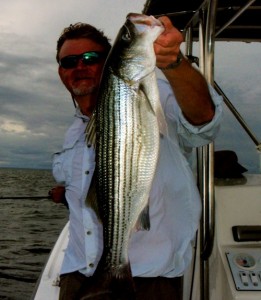 We’ve enjoyed a pretty good spring of light-tackle fishing on the Chesapeake Bay. Water temperatures warmed early, then leveled off through the end of April into May. Top-water casting is good right now at some places. Some anglers are even sight-casting surface lures and flies to cruising fish on shallow oyster bars near the mouths of the rivers. The water in some parts of the Upper Bay is clearer than I’ve ever seen it. While that makes surface fishing enjoyable, it also makes jigging tough since it’s easier for stripers to distinguish the difference between our lures and baitfish. The clear water looks nice, but there’s a big problem lurking below the surface: Low dissolved oxygen (DO). Measured in milligrams per litre, dissolved oxygen levels were recorded at 1.04 on the bottom beneath the Bay Bridge in April. That’s lower than they’ve been in twenty-five years. Look out for big algae blooms coming soon. Salinity also peaked to record levels in April. Last spring, Bay Bridge salinity was 4.20 ppt. This year, it’s more than twice that at 10.50 ppt. DO levels are also low in Eastern Bay, although salinity there is closer to normal. What does this mean for the fishing? Read More!
We’ve enjoyed a pretty good spring of light-tackle fishing on the Chesapeake Bay. Water temperatures warmed early, then leveled off through the end of April into May. Top-water casting is good right now at some places. Some anglers are even sight-casting surface lures and flies to cruising fish on shallow oyster bars near the mouths of the rivers. The water in some parts of the Upper Bay is clearer than I’ve ever seen it. While that makes surface fishing enjoyable, it also makes jigging tough since it’s easier for stripers to distinguish the difference between our lures and baitfish. The clear water looks nice, but there’s a big problem lurking below the surface: Low dissolved oxygen (DO). Measured in milligrams per litre, dissolved oxygen levels were recorded at 1.04 on the bottom beneath the Bay Bridge in April. That’s lower than they’ve been in twenty-five years. Look out for big algae blooms coming soon. Salinity also peaked to record levels in April. Last spring, Bay Bridge salinity was 4.20 ppt. This year, it’s more than twice that at 10.50 ppt. DO levels are also low in Eastern Bay, although salinity there is closer to normal. What does this mean for the fishing? Read More!
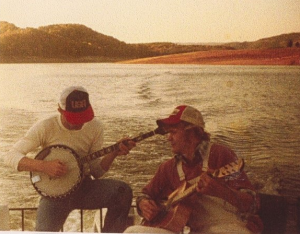 In my book, fishing and music go together like blue crabs and Old Bay seasoning. It’s hard for me to imagine one without the other. I’ve been singing, playing, and writing music for as long as I’ve been fishing. Here’s a shot of me with my best friend Curtis Seals from back around 1979 picking and grinning on the deck of the houseboat I called home. You can’t tell it, but Curtis is steering the outboard with his left foot while he picks his banjo. That takes talent!
In my book, fishing and music go together like blue crabs and Old Bay seasoning. It’s hard for me to imagine one without the other. I’ve been singing, playing, and writing music for as long as I’ve been fishing. Here’s a shot of me with my best friend Curtis Seals from back around 1979 picking and grinning on the deck of the houseboat I called home. You can’t tell it, but Curtis is steering the outboard with his left foot while he picks his banjo. That takes talent!
Many of the songs I’ve penned relate to the water in one way or another. My songwriting has slowed in the past few years because, in my opinion, a good song needs a firm sense of place. After moving away from my home in the Appalachian Mountains to this Chesapeake Bay country, I needed to thoroughly steep myself in the culture before trying to translate local images into songs. A few verses have been showing up in my head lately though, and my old Martin D-18 guitar is coming off the stand a little more frequently than it used to. My son Daniel has a gift for immediately capturing the spirit of the places he visits. He recently turned out a chilling ballad about the ghost of a barge captain who haunts the waters around Cape Charles, Virginia. I’m excited about the song because it’s laced with images of hurricanes, lighthouses, oyster bars, diving gannets, and blitzing rockfish. I hope he’ll record it soon. Read More!


